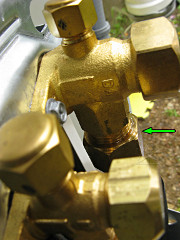
The bloody thing was *leaking*.
A still picture can't really show what I discovered, but this short video can.
| We were almost done. The correct HRV still had yet to arrive, and I would be doing other minor ductwork fixups around the house myself later. But in the meantime I had this new heat pump system to play with, although in June there's generally not a lot of heating or cooling needed so actual capacity measurements would have to wait a while. I could nonetheless take a look at all the many settings and service modes whose descriptions in the manuals had intrigued me so much. I also wanted to check various fasteners for stripped threads and get some anti-seize onto some of what would be the more frequently-accessed screws, making a mental note to caution the installer to only use hand tools on them from now on as he also had that industry-wide pernicious tendency to grab the impact driver by default. |
A disturbing discovery

|
So I pulled the cover off the outdoor unit to poke at its buttons and check
that its various settings were still the factory defaults, and it was a
good thing I took the time to look in here. Because human vision is so
adept at spotting movement and changes, I happened to notice a tiny bubble
appear on top of the larger flare fitting, move along the threads a little
way, and disappear. And this kept happening. The whole fitting was
covered in oil, and it was oozing down into the pipe insulation.
The bloody thing was *leaking*. A still picture can't really show what I discovered, but this short video can. |
|
Then he did something that's not recommended or even documented at all in
the manuals but is a common procedure on other units -- a pumpdown. This
is a hack that lets the unit compressor push most of the refrigerant
into the condenser and store it there behind the service valves, allowing
the lineset or indoor parts to be opened up and serviced without having to
replace the entire charge. It is usually done by closing off the liquid
line and
manually engaging the big electrical contactor that makes the compressor
run until the low-side pressure drops to near zero -- except that this unit
doesn't have the obvious contactor so we had to kludge around that.
He had me go inside and call for high cooling, closed the liquid valve and let the lineset pressure drop down to about 40 PSI, whereupon he quickly closed the other valve and then simply yanked the disconnect to shut everything down. Said that if you wait too long, the unit shuts down on an underpressure alarm and loses the pumpdown back into the lineset. So at this point, in theory most of the refrigerant was now stored as liquid in the condenser unit's coil and other plumbing. According to Daikin, this is a bozo no-no on these units and the proper procedure is to put the unit in a special mode that fully opens all the internal valves, and then recover all the refrigerant out of the entire system before trying to work on it. But he figured on a leaking system that he hadn't added any extra juice to the system in the first place, it could all be put back into the condenser where it had originally come from at startup. |
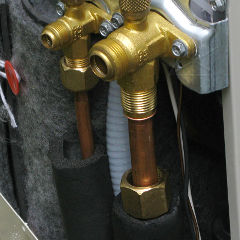
|
Anyway, we both looked at the flare itself and despite its having been done with his cheap tool it looked okay to both of us so he put it back together. Still without any sealant or lubricant like Nylog Blue which appears to be thought of highly around the industry as a good leak preventative. With the difficulty he'd had bending the large line, including the final 90 up to this point, it's possible that the flare wasn't quite squared up to the valve fitting the first time. |
|
I was fine with sort of a half-done installation on the HRV because we
both understood that I'd be moving the connections around and playing with
all of this later.
I also temporarily hooked up the controller, nominally slated to go
upstairs somewhere, right next to the unit on a short wire so I could
explore what it does. I needed the fancy "EDF5" type controller for the
best versatility in fan speeds and timed cycles, so that's what we ordered.
It connects to the HRV on a simple two-wire interface that again, just
like the heat pump system 'stat, carries power and data.
We went back outside to check on the vacuuming, and he realized that he wasn't actually getting a good vacuum at all and that the reason was that his pump was really low on oil. Vacuum pumps need a proper level of oil sump to fully seal the running parts and achieve good suction, and as a tiny bit of the oil always gets pushed out with the discharge it needs to be kept topped up -- something not always done in a timely fashion on a piece of kit banging around in the back of an HVAC service truck. It seemed like the installer was also suspecting leakage in his own test hoses or fittings, possibly influenced by a half-snide related comment I had made earlier in the day. In any case, he decided he needed to take about a two-hour break to go shopping. This was my opportunity for some initial ventilation system testing, part of which would involve swapping the flex ducts around particularly to mess with the Cape backdraft damper. |
|
Okay, so here were two substantial tubes right into the building envelope
that would frequently have really cold air passing through, and the next
question was this: what effect would that have on overall insulation
value? In theory, it's easy to calculate: Assuming that the problem ends
at the HRV and we don't consider the "tempered" inside ducts,
the fiberglass blanket around the 6"
duct is about two inches thick. Calling it an average radius of 4 inches
at the center of the insulation over maybe 18 feet of duct yields an
effective wall area of 38 square feet. This would be like adding a
roughly 6 x 6 foot section of wall to the house at R-8 instead of the
nominal R-26 the main retrofit would bring. But the longer exhaust
duct wouldn't run at exactly outdoor temperature, since the heat exchange
in the HRV isn't perfect and to complete the picture one must also
calculate heat gain/loss in the exchanged air volume itself and factor
in the HRV efficiency rating. Still, in comparison
to the building's 2300 or so square feet of above-grade surface area, the
duct walls of these short runs are down in the noise. Why worry about it
in the first place? No outstanding concerns, it was just yet another in
the series of informal HVAC engineering exercises I was having fun
putting myself through.
A less than satisfactory wrapup The installer finally returned, bearing a bottle of vacuum pump oil, a new set of gauge hoses, and his favorite ol' analog Yellow Jacket manifold gauge set. Still no real micron gauge. His pump took the *entire* bottle of oil just to come up to the correct level, while he admitted that he really hadn't paid proper attention to this for ... how many other jobs, customers, and perhaps insufficiently-vacuumed systems before this one?? but with that all fixed and happy now, he once again hooked up to the valves and started suckin' 'er down. With the analog gauges in place now instead of the digital widget, we could at least watch the low-side needle plant itself pretty firmly into the negative region. While that was going we went back inside for the final installation step, bolting in the resistance heating module. [More on that later on.] That was easy, as it's two power connections and a control plug. The headscratching part was figuring out how to configure the system's "field settings" to tell it that the heater was installed. I already knew how to do this from reading the manuals but I figured I'd let him sort it out his own way, in which he again made it clear he hadn't done this particular variant of system modification before. Well, not that the user-interface of the remote controller upstairs makes it a straightforward task in terms of button presses. But we got through it and I figured that I'd just have to wait for cool weather to actually put the heater through the testing paces. Back outside to the condenser, which we figured was about as vacuum-dried as it was going to get that day. He pulled off the pump and let the refrigerant back out of the outdoor coil, and the next problem was figuring out how much had leaked out. With a system with feedback-driven computer control that's able to adapt well to a large range of improper charge, how do you do that? Not by target subcooling charts, that's for sure. Well, our fella had another somewhat old-school albeit possibly handwavey idea. We started up the system in high cooling mode again, and he simply let new refrigerant into the liquid side in little squirts until the low-side pressure settled in around 140 PSIG, corresponding to about 50 degrees on the R410A saturation curve. Total guesswork -- he didn't even check what the actual temp of the indoor coil was at the time, but at least it got a little more refer into there. Said it "took about a pound", called it done, and buttoned everything back up.
This felt like a total hack job to me but I reined myself in and tried to
not stand there and tell the guy how do perform his "been doin' this for
a lotta years" job. I figured I'd ask around later and find out just
how hack it might have been, and the raw evidence can be found in these
two forum threads:
As the back of his truck retreated into the distance that afternoon with my final check inside, I realized that I would probably never see him again and likely had very little recourse as far as this commissioning laxity. I'd already bounced some of these doings off Daikin's support engineers who had agreed "ooh, that's not good" but there was very little they could actually *do* about it -- they train contractors, but don't control them in the field. It began to fully come home to me what one of the hvac-talk guys had said, how the residential HVAC market is such a joke. Mind you, on the overall system he'd basically built what I specified and had done a pretty good job on the ductwork and adaptation inside, so it certainly wasn't all bad. But as far as system startup and long-term reliability, about the only path open seemed to be finding another tech who would actually give a rat's ass and having them work the thing over and give sounder advice. Which I eventually did, detailed later in the saga. For now that could wait, as the heat-pump system was for the most part working [and presumably not leaking anymore] and I already had a whole slew of other post-contractor fixups that *I* wanted to do. |
HRV Hacks
|
The backward-curved fans don't really have a shaped volute around them
to direct airflow, but with the cover closed up the chambers they run
inside seem to pressurize and exhaust well enough out the delivery ducts
[esp. after being optimized a little more]. I played around with the
controller some, figuring out how to set speeds for various overrides
and the cycle timer, and then put the HRV back together and mounted it up
on taller, correctly-sized and more stable blocks on the table. This
let the cold-side ducts reach it better and keep the insulation continuous
all the way down to the outer collar and outside of the box.
The defrost damper basically switches between normal outdoor-air intake and pulling from the basement air right by the box. It actually closes off the intake reasonably well in standby state, preventing what could otherwise be a significant infiltration source. Its actuator is simply a little low-power AC gearmotor turning against a spring, and once the damper is swung all the way to the defrost or "outdoors closed off" position the motor stalls against a stop while still under power and thus sits there and gets rather warm. No provision is made for lowering the current through it once it's done its brief little job, so I expect that'll be one of the first parts to fail. Bad design; this would have been easy to run through a phase-switched triac or something. I floated several of these issues to the support folks back at Fantech, which they hopefully took in the right spirit as product-improvement suggestions. Some of this stuff is really basic. In return they were pretty helpful later when I was trying to figure out some of the integration connections between the HRV and the air-handler. The HVAC installer had left me almost a whole bag of "duct straps", aka huge long zip-ties, since he knew I'd be making changes to various hookups. These are actually hard to get tight enough onto flex duct so it actually stays on a smooth fitting. I later determined that a twice-around cinch with the black theatre tie-line I have plenty of with a taut-line hitch actually works way better and is completely reuseable. |
A/C hacks
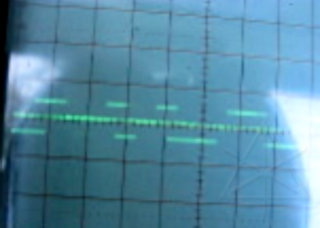
|
The signaling itself appears to be short bursts of differential data
applied over a 16V DC bias, at about 9600 baud. The bursts are relatively
infrequent, and it takes a few minutes for the system to notice and
respond appropriately to either opening or closing the data-line switch.
Because the system is powered from 240VAC and most plug-in scopes are internally grounded, I had to do all this observation with two probes in differential mode. The low-voltage power supplies inside are floating, and I didn't want to simply short some part of the system to ground. |
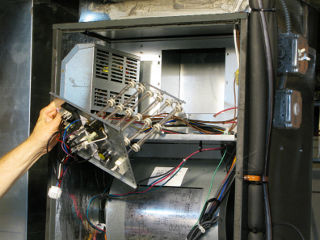
|
I pulled the auxiliary resistance heater, aka "big toaster", back out to
have a better look at it. Simple and brute-force. It has its own relay
and overtemp protection widgets built on, using a simple 24VAC output
from the main control board to fire it up.
On the heater plate is where I observed the Goodman label, my first hint that the whole unit might be from them too. Knowing that now also helps explain why some things about the unit seemed a little odd, such as the lack of a return-air temp sensor which most other Daikin-made indoor units seem to have. However, it gets even more confusing: much later on I found out that the heater itself is made by Warren Technology out of Hialeah FL, same town as the refurb electric meter company. |
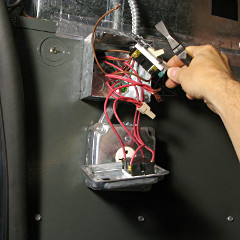
|
Because the air handler and aux heater both run from 240VAC circuits, the installer provided a 240VAC condensate pump. For some reason the electricians had wired the outlet for the pump to the *heater* circuit instead of the main AHU circuit, which doesn't make any sense as the circuit for the heater is usually shut down when the unit is in cooling mode. So I decided to open up the box and rewire the whole mess with the pump coming off the air-handler circuit, cleaning things up and eliminating a couple of excess wire-nuts in the process. |
ECM games
|
I tried to do some airflow measurements with my small anemometer, for
example by taking an "averaging scan" over the filter-box opening with
the cover and filter removed and the return duct from the house blocked
off. What I came up seemed quite a bit lower than what the listed spec
for the unit is, and I'm not sure why -- must have been some
directionality effect going on, or the head area on the anemometer
interferes with itself too much, or something.
But part of this screwing around involved researching the behavior
of ECM blower motors,
which this has one of in the "ECM 2.3" version. Yes, brushless
electronically-controlled air-handler fan motors actually have versioning
that has progressed over recent years.
This is because most of them are made by the same company, which is a
confusing conglomerate involving GE, Genteq, Regal-Beloit, and a fairly
unfriendly website called
thedealertoolbox.
Bottom line is that ECM units are far more efficient than old-school permanent split capacitor induction motors, as they drive a three-phase permanent-magnet motor at fully variable speeds using power transistors. Gee, does *that* sound like a recurring theme?? Long bit of research shorter, the controllers bolted onto the backs of these motors actually get factory-programmed with different torque and RPM curves that allow them to maintain constant *airflow*. That means as ductwork becomes more restricted, the blower will spin faster and harder to make up for it and try to keep the same amount of air going through. The extreme case of this can easily be witnessed by blocking up the whole return path, which causes the motor to go from its normal gentle almost-silent operation to more like a screaming jet engine at high RPM. Just by restricting airflow, not even changing any fan settings. The motors are also designed for direct integration into furnaces and air handlers, taking various commands and speed controls into a low-voltage interface at the same 24 volts AC that thermostats and burners and everything else uses. So the "fan" and "heat" and whatever terminals from a 'stat can be wired straight to the blower motor and not only enable more efficient and more stable operation, but eliminate the need for extra fan relays and such in the process. Feed these things power and control, and they just work. They even have built-in post-run delays before stopping, to allow for cooldown and the like, and capability to accept some simple diode logic to select different speeds via half-wave control inputs. There's a comprehensive textbook (pdf) on all this stuff at Prokup Media's training site, and numerous other findable online references. Speaking of post-run, one of the first things I noticed about the air handler was that any time the system was set to "on" at the controller in heating or cooling mode, the fan was running at the selected speed -- even when it wasn't actively heating or cooling. This is dumb, especially in cooling mode, as the last thing you want to do is stop running the compressor and let the indoor coil go warm with all that water still loaded up on it -- thus blowing the humidity you just worked to capture right back into the house. The fan in a cooling situation needs to STOP and let the coil quietly drain down into the catch pan. Long story shorter on *that* is that Daikin's application-engineering folks were kind enough to send along the "seekrit field settings" PDF which detailed how to configure the fan to go OFF after heating or cooling setpoints are satisfied. Yep, two different settings I needed to go up to the controller and wander through the field-settings menu to set -- 12(22)-3-03 for heat and 12(22)-6-03 for cool, specifically stated here in case you're up against the same problem. Probably works across a large cross-section of Daikin units, as field settings seem to be fairly consistent among them. In this particular AHU, the ECM fan itself is programmed with a 3-minute off delay, which is just barely short enough to extract the last bit of residual "cold" from the coil but not run it too long above dewpoint. It'll do for now, especially as reprogramming the ECM involves some proprietary piece of gear that almost nobody has. This clinched one of the reasons that return-air sensing wouldn't have worked here. Dry-bulb temperatures in the basement and thus inside the air handler without the blower running could be very different from upstairs, which would totally wack the system's idea of demand. One of the nicest features about Daikin and the other inverter-drive systems on the market is that they can ramp down their own compressor speeds and thus working capacities as they approach setpoint, particularly in cooling, and continue to run in a low-power but very efficient way for quite a while longer to actually reach it. Sometimes with a high latent [moisture] load on low fan, this one will run for three or four hours at one degree below the controller setpoint while still pulling lots of water out of the air, rather than cycling on and off like typical old-school units. This is worlds-apart better for humidity control. They can do this because of all the temp sensors attached to the pipes at either end of the coils, and control their electronic expansion valves to run at precise levels determined from observed conditions. The pressure's on
*Note: Some of the following paragraph is wrong, at least in a static setting with the system not running and equalized. Because: refrigerants in a saturated mix do not actually change pressure based on liquid volume. That's what's so magic about them. *Any* liquid present makes a refrigerant at rest simply obey the pressure/temperature chart, regardless of relative quantity of liquid or gas. There are even "trick" questions on the EPA 608 certification tests that cover that. In a correction applied around 2020, I have struck out the erroneous information. Having taps into the pressure sensors is still useful, however, especially in heating mode where both sides of the physical lineset become "high side" and there's no way to know suction pressure except from a tap just before the compressor. Which the low pressure sensor is.
In further wandering through various Daikin system documentation, much of it not even pertinent to my specific unit, it dawned on me that I just might have the next best thing. The condenser unit has *pressure sensors*. Not just over/under pressure limit switches -- it has them too -- but actual sensors to read high and low line pressure back into the control board in a nice linear fashion. The schematic showed right where they hook in, too: simple 5V power, ground, and sense leads. This demanded immediate investigation. |
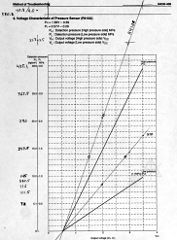
|
One big hint that I might be able to read system pressures electrically
was finding a couple of pressure vs. voltage charts squirreled away in
some of the more commercial unit documentation. In particular,
this one
which isn't even hosted in the US showed the charts for R22 and R410A, but
had the curves and voltage-to-pressure transforms a little mixed up so
after printing out the page I had to draw in the extra lines for R410A.
But once I had that and filled in all the rest of the pressures in PSI
against their MPa scale, the voltages I was seeing made sense. Upon
starting the unit for cooling, both high and low sensors settled right
in at right around 2 volts each, telling me that they'd been selected
to read a nice mid-range when running in typical ambient conditions.
This was showing me about
300 PSI and 120 PSI, pretty nominal for R410A in
|
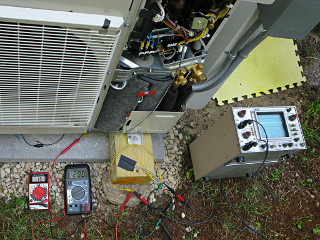
|
As I posted to my Prius tech group later, it resembled a familiar situation -- tapped signal wires brought out to measuring equipment to gain better insight into some control system, but this time it wasn't the car, it was my heat pump. All the parallels with developing the Prius instrumentation were highly amusing. And I could easily argue that I shouldn't even have had to do this, as it would have been trivial for Daikin's control coders to allow retrieving pressure-sensor data from the controller inside the house with a few keypresses. Isn't that something that would help techs in the field too? Walk into a customer's house, punch a couple of buttons on their thermostat, and get a complete system picture without even pulling any gear out of the van, including that cumbersome and dog-slow "service checker" laptop setup. Daikin, wise up. |
|
The data-collection frenzy continued, as high humidity over the next few
days was a good opportunity to run the system and try to keep the basement
relatively dry. Instead of letting the condensate pump take the extracted
water away, I pulled the pump completely off the drain pipe and started
collecting
into buckets, just to get an idea of how much latent load was being handled.
Later I started *weighing* the buckets on the hour to quantify that, and
tried to figure the running capacity
on the psychrometric chart,
but there were still too many unknowns stemming from the still leaky and
not-well-insulated house. Nonetheless, it was squeezing on the order
of 4 or 5 pounds of water out of the air per hour.
It should be noted that condensate water is really nasty, icky stuff, especially from a new coil. It comes out carrying various oils and crud from the manufacturing process, and will never become "clean" since as the original guk on the coil slowly washes away, it'll get replaced with all the guk picked up from the return air that the filter didn't catch. In other words, *don't drink the condensate*. |
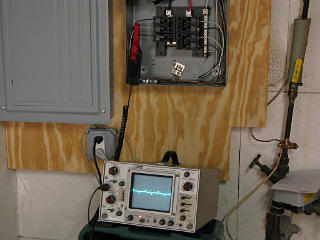
|
Even the air handler just running the fan only is pretty peaky on current
draw, which is probably a side-effect of the essentially-SMPS nature of
the ECM driver. This looks like what you get from a textbook
bridge-rectifier-into-filter-caps setup.
[The scope, just to note, came from the Frostbyte auction. Still working nicely.] |
|
In anticipation of less air leakiness I wanted a better way to monitor
indoor air quality, and ordered a CO2 monitor from
CO2meter.com. Not a carbon MONoxide alarm like most households have,
a carbon DIoxide meter so I could see just how my own breathing would
affect the air inside the house. Normal outdoor fresh air, for where we
are on the "hockey
stick" right now, is about 400 PPM and anything under about a thousand is
considered "okay" for building interiors.
The evening after it arrived I locked it and myself in one small closed room for the night's sleep, as in fact I had done any number of times over the past winters ... and managed to drive it up to about 2400 PPM. Yeah, that air didn't smell too good the next morning either. Further observation revealed an interesting partial-pressure situation, where the CO2 level inside would rise more slowly the higher it gets and opening doors or windows somewhere *else* in the house from where the meter sits started lowering the PPM anyway. Like the CO2 diffuses evenly into the entire interior volume regardless of where I am or where the meter is, and wants to equalize fairly quickly through any substantial opening in the envelope. |
Getting down to business
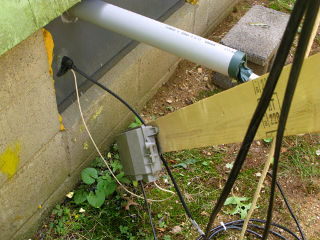
|
The FiOS fiber had to be backed completely out of the optical network terminal inside, and re-run through another new penetration pipe [made *just* big enough for the connector head] along with the phone wire. The phone box could just hang on the post bracing, and I didn't spend a lot of time fussing with that as I care far less about phone lines as I used to. The landline has become less and less useful over time and at this point I don't even answer it anymore, as all the incoming calls are nothing but spam nowadays. "Lower your credit card rate!", alarm systems, win-a-cruise, political surveys ... all total junk and that's despite being on plenty of do-not-call lists. All these sleazebags can just talk to an answering machine. |
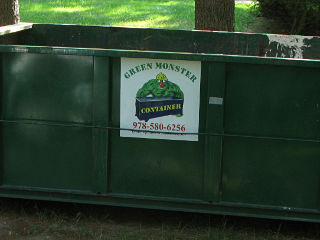
|
And the name of the disposal company is just priceless, given that we're in the Boston area. Go Sox?? Is that what I say here? |
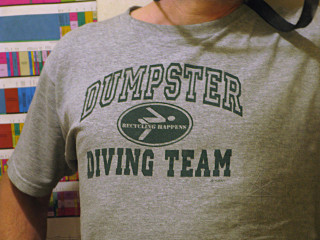
|
I had no idea the guy was coming when he did, but by pure coincidence I happened to be wearing this shirt that morning. There was much amusement all around. |
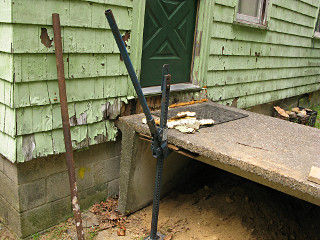
|
The contractors would need to bulk the entire house out by several inches in the process of adding the new insulation, so the stair set needed to be pushed away from it. This precast unit, probably purchased many years ago from the concrete plant right down the road, is deceptively heavy despite its hollow design -- probably weighs well over a thousand pounds, and had been solidly set on the ground here for many years. My old "hi-lift" truck jack managed to float it up just enough that I could pry it away from the house a little way, enough to get at the siding behind it. The stair unit had been jammed right up against the siding for so long, letting water seep down into the crack and get held, that here's where I expected to find some of the worst rot problems. |
|
The yellow mark on the foundation is one of several splotches of paint where
I went around and tried to mark areas where electrics were routed up inside
walls and thus locations the contractors should be careful around. I was
really trying to anticipate and accomodate everything I could for them.
It was also an interesting mental shift to start perceiving so much more of the house's exterior as expendable, giving me absolutely no qualms about destroying parts of it as long as it didn't compromise water-resistance too badly. And I could just slap temporary shielding material of some sort over opened-up areas if needed because it was all going to be academic in another few days anyway. | |
_H* 120714